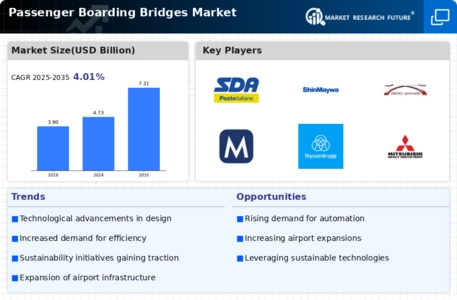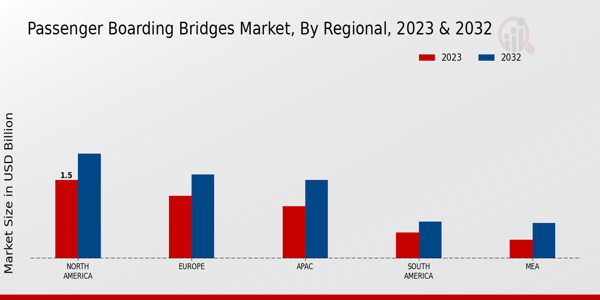Market Trends
Introduction
In 2023, the Passenger Boarding Bridges Market is experiencing significant transformation driven by a confluence of macro factors including technological advancements, regulatory pressures, and evolving consumer behaviors. Innovations in automation and smart technology are enhancing operational efficiency and passenger experience, while stringent safety and environmental regulations are compelling stakeholders to adopt more sustainable and compliant solutions. Additionally, changing consumer expectations for seamless travel experiences are pushing airports and airlines to invest in modernized boarding infrastructure. These trends are strategically important for stakeholders as they navigate a competitive landscape, ensuring that they remain responsive to market demands and regulatory requirements.
Top Trends
-
Increased Automation in Boarding Bridges
The trend towards automation is reshaping passenger boarding bridges, with companies like JBT Corporation leading the way. Automated systems can reduce boarding times by up to 30%, enhancing operational efficiency. Airports are increasingly adopting these technologies to streamline passenger flow, as seen in recent upgrades at major international airports. Future developments may include AI-driven systems that further optimize boarding processes. -
Sustainability Initiatives
Sustainability is becoming a priority, with many airports implementing eco-friendly boarding bridge designs. For instance, Menzies Aviation has introduced energy-efficient models that reduce carbon footprints by 20%. Regulatory pressures are pushing airports to adopt greener technologies, which could lead to a significant shift in manufacturing practices. Future trends may see the integration of renewable energy sources in bridge operations. -
Smart Technology Integration
The integration of smart technologies in passenger boarding bridges is on the rise, with features like real-time monitoring and predictive maintenance. Companies like Thyssenkrupp are investing in IoT solutions that can reduce downtime by 15%. This trend is driven by the need for enhanced operational reliability and passenger experience. Future developments may include advanced analytics for better resource allocation. -
Customization and Modular Designs
Customization is becoming essential as airports seek to meet specific operational needs. Modular designs allow for easy upgrades and modifications, as demonstrated by AeroBridge's recent projects. This flexibility can lead to cost savings of up to 25% during renovations. The trend indicates a shift towards more adaptable infrastructure, with future designs likely to incorporate modular components for rapid deployment. -
Enhanced Passenger Experience
Improving passenger experience is a key focus, with features like wider bridges and better accessibility being prioritized. Airports are investing in designs that accommodate diverse passenger needs, as seen in recent upgrades by Fraport. Enhanced comfort can lead to increased passenger satisfaction scores, which are critical for airport ratings. Future trends may include personalized services integrated into boarding bridge technology. -
Digital Twin Technology
Digital twin technology is emerging as a game-changer in the design and maintenance of boarding bridges. This technology allows for real-time simulations and predictive maintenance, reducing operational disruptions. Companies like Kone are exploring these innovations to enhance efficiency. The future may see widespread adoption of digital twins, leading to more proactive management of airport infrastructure. -
Focus on Safety and Security
Safety and security enhancements are paramount, with new designs incorporating advanced surveillance and emergency protocols. Recent initiatives by governments have mandated stricter safety standards for boarding bridges. This focus can lead to a 10% reduction in safety incidents at airports. Future developments may include biometric systems for secure access to boarding areas. -
Global Standardization Efforts
There is a growing push for global standardization in boarding bridge designs to ensure compatibility and safety. Organizations are working towards unified specifications, which can streamline operations across international airports. This trend could reduce operational costs by up to 15% through standardized training and maintenance. Future implications may include a more cohesive global airport infrastructure. -
Integration with Airport Management Systems
The integration of boarding bridges with comprehensive airport management systems is becoming increasingly important. This allows for better coordination of boarding processes and resource allocation, as seen in recent implementations by Airport Equipment Ltd. Improved integration can enhance operational efficiency by 20%. Future developments may focus on seamless connectivity with other airport systems. -
Investment in R&D for Innovative Solutions
Investment in research and development is crucial for driving innovation in the passenger boarding bridges market. Companies are allocating significant resources to develop cutting-edge technologies, with a reported increase of 15% in R&D spending in 2023. This trend is essential for maintaining competitive advantage and meeting evolving market demands. Future innovations may lead to breakthroughs in bridge design and functionality.
Conclusion: Navigating the Passenger Boarding Bridges Landscape
The Passenger Boarding Bridges market in 2023 is characterized by intense competitive dynamics and significant fragmentation, with both legacy and emerging players vying for market share. Regional trends indicate a growing demand for innovative solutions, particularly in Asia-Pacific and North America, where airports are increasingly prioritizing modernization and efficiency. Vendors must strategically position themselves by leveraging capabilities in AI, automation, sustainability, and flexibility to meet evolving customer expectations. Legacy players are focusing on enhancing their technological offerings, while emerging companies are disrupting the market with agile, sustainable solutions. As the industry continues to evolve, decision-makers must prioritize investments in these key capabilities to secure a leadership position in this competitive landscape.














Leave a Comment